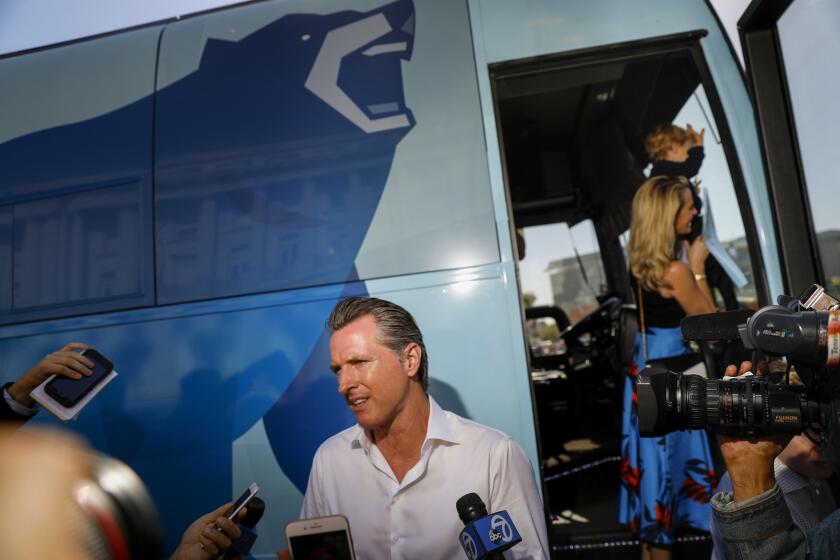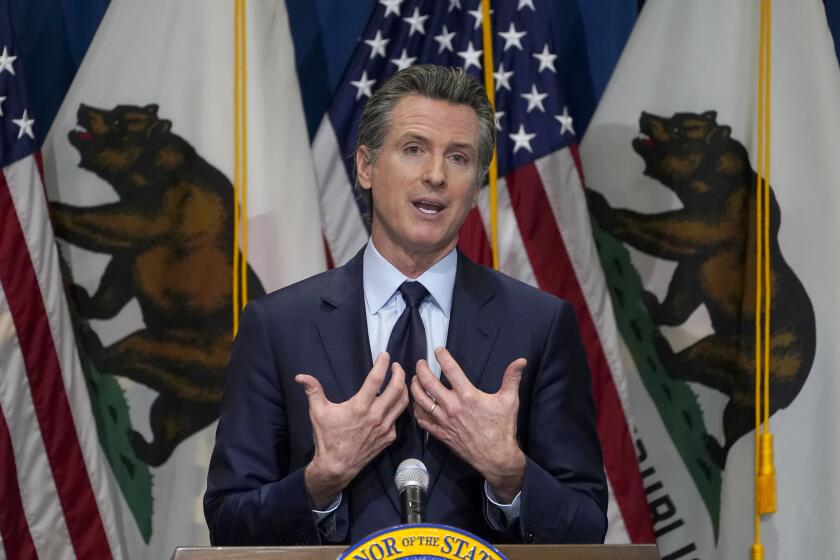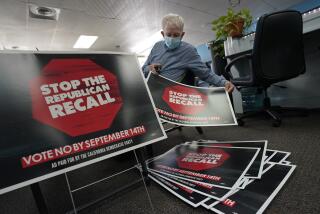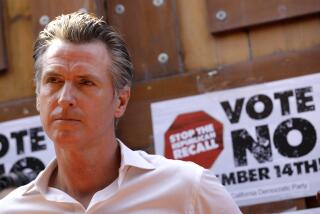The effort to recall Gov. Newsom hit big milestones this week. What you need to know

The effort to recall Gov. Gavin Newsom hit several milestones this week.
Recall forces completed their signature-gathering, another Republican joined the hunt and Newsom went on a national media tour in which he acknowledged the recall election is likely to happen.
Here is what you need to know about where we are:
Wednesday is the deadline for the recall campaign to submit signatures to the state to qualify an election for the ballot. Democrats across California are rallying behind the governor to prevent his ouster.
Where do we stand with the signatures?
Recall supporters said Wednesday night that they gathered more than 2.1 million voter signatures, likely more than the roughly 1.5 million valid signatures needed for an election to take place. Organizers handed in last-minute petitions to county registrars Wednesday as the campaign’s leaders celebrated the nearly year-long effort.
“Later this fall, the voters of California will be able to participate in this historic, once-in-a-lifetime opportunity to participate in a recall of their chief executive officer,” said Randy Economy, senior advisor for the recall effort. “It’s a very, very powerful moment.”
The attempted recall of Gov. Gavin Newsom will go before voters on Sept. 14. Here are the details.
Though the certification of the signatures could take several weeks — elections officials must determine how many are valid by April 29 — Newsom acknowledged Tuesday that he expects the recall effort to qualify.
Who is running?
Former GOP Rep. Doug Ose this week added his name to the list of Republicans in the race to replace Newsom should the recall qualify for the ballot. Already planning to run are former San Diego Mayor Kevin Faulconer and businessman John Cox, who unsuccessfully ran against Newsom for governor in 2018.
Supporters of Newsom are trying to prevent any Democrats from entering the race. That could be key. In 2003, Gov. Gray Davis faced a celebrity Republican — Arnold Schwarzenegger — in addition to many other lesser-known candidates. But there was also a prominent Democrat in the race, then-Lt. Gov. Cruz Bustamante.
Davis was recalled and Schwarzenegger was elected.
What did Newsom do this week?
He went on a national media tour and for the first time talked extensively about the recall.
He vowed to not only beat the recall effort but to run for reelection in 2022, saying he was proud of his administration’s efforts to vaccinate Californians and rekindle a state economy battered by the COVID-19 pandemic. He noted that several recall efforts have been launched against him since he took office in 2019.
He vowed to not only beat the recall effort but to run for reelection in 2022, saying he expects that his administration’s efforts to vaccinate Californians and rekindle a state economy flattened by the COVID-19 pandemic will be a major success.
“Just in 25 months, there’s been six efforts to put a recall on the ballot. This one appears to have the requisite signatures,” Newsom said during an appearance on ABC’s “The View.” “If you look at the list of grievances from the proponents of this campaign, it goes to our values. It’s less about me, it’s more about California and our values — Democratic Party values.”
Newsom also criticized the need for a recall election, calling it a “waste of time” and money since the 2022 gubernatorial primary will be just a few months later.
“I’m looking forward to defeating this recall, getting more shots in people’s arms, getting this economy roaring again,” Newsom said during an appearance on CNN’s “The Lead with Jake Tapper.”
What about the Feinstein comments?
In the eyes of some Democrats, Newsom stumbled Monday when he told MSNBC’s Joy Reid that, should California Sen. Dianne Feinstein retire, he would appoint a Black woman to replace her, noting that he already had a list of several Black women whom he would consider.
Newsom came under pressure late last year to fill Vice President Kamala Harris’ Senate seat with a Black woman, but instead appointed then-Secretary of State Alex Padilla, California’s first Latino senator.
If Sen. Dianne Feinstein retires, Gov. Gavin Newsom said Monday he would nominate a Black woman to fill the seat.
Feinstein, 87 and facing questions about her mental acuity, reiterated that she had no plans to retire and Newsom downplayed his statement Tuesday — but not before riling up some members of the California Democratic Party Women’s Caucus, who voiced their frustrations to Chair Christine Pelosi that Newsom’s discussion about a replacement for Feinstein before she left office was not a good way to rally the party faithful.
“I would hope that they remember there are a lot of women who vote in the recall, and it’s not a very good look to pit women together to save the job of a man,” Pelosi said of those organizing Newsom’s campaign.
What’s next?
The signatures collected by recall supporters must now be counted and validated by elections officials in California’s 58 counties.
If the recall qualifies, the timing of a special election is uncertain. A vote would likely take place in November, political observers say. Voters would be asked two questions: Do they want to recall Newsom? And, if Newsom is recalled, which candidate would they want to replace him?
More to Read
Sign up for Essential California
The most important California stories and recommendations in your inbox every morning.
You may occasionally receive promotional content from the Los Angeles Times.

















